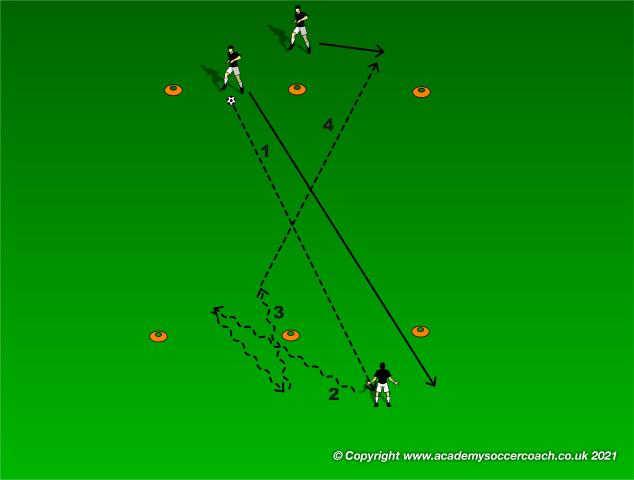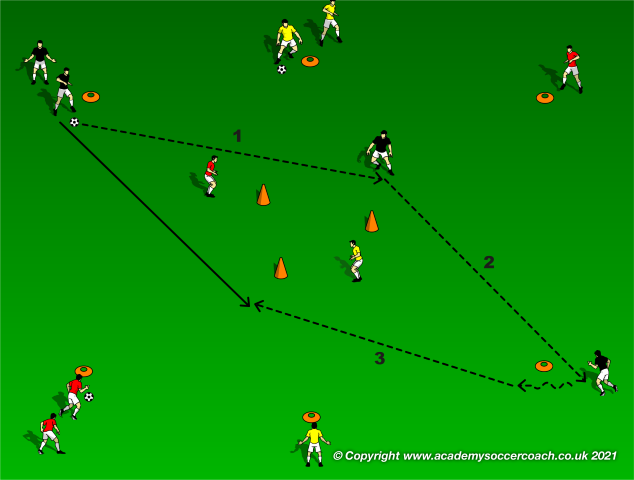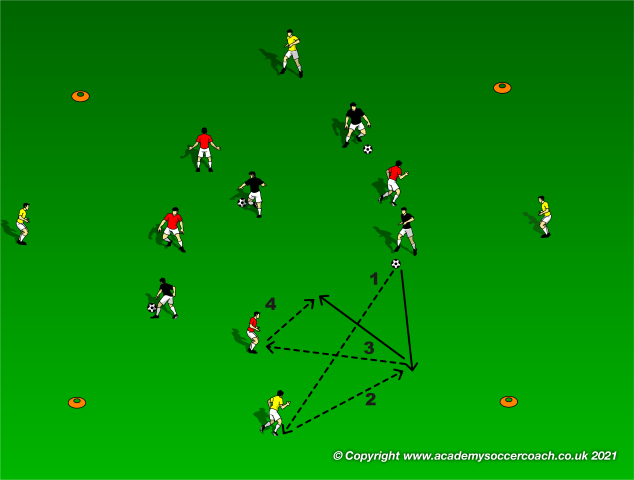By Matt Carroll -
Thanks to Pep Guardiola’s work at FC Barcelona and their so called “Tiki Taka” style of play many aspiring coaches of youth football fell in love with the game based on possession of the ball in the last 10-15 years. I find it as a very good trend as it forces young players to master the ball and make good decisions under pressure instead of just playing direct football. However, coaches cannot get too excited and go into too much detail with young players at once. The learning process must be planned well so we don’t overload them with too much information.
So many times, I have seen coaches moving their U10/U12s players into triangle/diamond shapes on the pitch while freezing the play. They are not robots! Kids must be given time and simple instruction which will result in their understanding of how to position themselves in relation to the ball, teammates, and opponents on the pitch. Drills presented below are much more interesting for your players than treating them like magnets on tactical board. All of them will result in players progressing in that aspect of the game. They will automatically start supporting each other by giving good angles and as they start doing it you can stop the session, praise them, and show good examples of what they have just achieved.
The key is not to kill their love in the game. Football is becoming quicker every year; more and more teams build their game around being good in transition. Young players love running with the ball which if mastered can be a very valuable skill in any style of play. Make sure that while you teach them the principles of possession, you don’t take the freedom of play away from them. Don’t make the sessions and drills all about the passing, but about the decision-making process which will improve them as players in all moments of the game. Possession is not equal to passing.
Start every session in that age group with ball mastery drills in warm-up. Do it in small groups of 2-4 players to maximize their time on the ball. Try to make them fun and intense. Perfect example for minimum of 3 players is a drill presented below.

Players must take a touch forward after receiving a pass and with minimum number of touches and quickest possible time turn with the ball twice through the cones and pass it to the other side. Players follow their pass. How can you connect it with your possession session? Teach them to receive it off their feet and explain importance of diagonal passes and giving angles to players. Before starting a session ask them a simple question connected to the subject of the session. In that case, give center back the ball and put your center midfielder in front of him with a player at his back. By that simple example you will show your players how giving an angle to the player on the ball allows them to turn with the ball forwards compared to being forced to play backwards if coming with no angle and bad body shape.
Give players different challenges on the ball, work on different turns and focus on the intensity and quality of movement on and off the ball. If more advanced group can ask them to time their movement off the ball and put their heads up when turning with the ball. Players can turn through both gates at their side and depending on how well they work you can ask them to use both or just one during the same set. Player on the other side then can be tested to adjust his position into the opposite gate to give a good angle.
Ball mastery is the key and improves players confidence on the ball and their comfort when facing pressure and limited time and space. The better the quality on the ball, the easier it is to showcase their skills and game understanding during the match. Make sure your players find it easy to control the ball and can run and turn with it at speed. Another drill which can be used to teach that principle of possession (ANGLES) is presented below while also improving the quality of the pass made at match speed.

Put players in teams of 4 or 5 in 2 groups opposite to each other. You can put any number of cones in the middle which represent the opposition team. I’m usually using 3 cones representing their center midfield. Start with 2 balls per team and players just running through or around the cones and pass the ball to the outside players. Outside players must give a good angle and touch the ball across the cone. You have just worked on running through-exploiting space in between players. So you can put that drill in another session which will be focused on breaking the lines of opposition.
Second stage is presented on the graphic above and requires one ball per team and one player in between the cones. Now we’re working on creating the right angles and passing through or around teams. Focus on giving the right angles (creating triangles within a team) and touching the ball across your body. Everything is done at match speed, within 2-3 touches while scanning so the balls and players of different teams do not meet any time. Players always follow their pass.
3rd level can be added with advanced teams and ask 2 players from each team to come in the middle. Now we’re asking the players to combine through “up-back” combination. Player who passes to the outside follows his pass, while last player who passed inside follows into the midfield so we keep 2 players inside.
Another drill that can be used focuses not only on creating angles but also on timing of support. As mentioned earlier the way of moving players like magnets on tactical board does not work as youth players need to learn by actions and trying out the new challenges that we present to them. The other way which is not going to work with every group, especially less advanced is to try and teach them everything within small sided games which is very popular now. That’s why presented drills are very useful. They can be done by mixed ability teams and allow players to repeat their actions many times while working under a bit of pressure which is created by working in a tight area and having many players around you. Players will improve their understanding of importance of off the ball movement and how it can affect the game.

In this drill we keep players in 3 equal teams. One team (blues) stay on the ball all the time. They try to find a green player who is available for a pass. And after that they offer a good angle to receive the ball into the space again. Outside players are asked to decide if to play them back one or two touch. Decision is made based on the weight of pass and the speed of “blue” player getting into right positions. Try to force players to play hard passes to the outside which will represent playing to a free player in wide areas in the game. After the pass back to “blue”, “red” players are asked to time their support runs perfectly and play a one-two with the blue players. One-two should be played at speed and allow the “blue” player to receive it on the run and allow him to find another outside player very quickly. Make the area as tight as possible to create a lot of traffic on the ball so the players don’t find it easy to run with it and find the next pass. But also maximize the space to make the length of the pass more real and minimize the amount of very short passes which should be used only in the one-two combination.
These 3 drills are very simple to organize but allow you to coach many tactical details that you definitely want your players to improve on. All of them allow a maximum repetition time which will make players learn and experience new things. The passing combinations, especially in the last one will be very game realistic if done at the right tempo. As mentioned earlier the main topic that I’ve focused on is offering good angles and timing the support. We can explain things on a tactical board for hours and even if players understand the importance of angles, nothing will be better for them than having 100s of times on the ball repeating the same movement but in constantly changing environment. And that’s what we should look for. It is not only about playing the game but testing and improving players by creating challenging drills. In that environment we will make sure they understand the tactical detail which makes it easier to coach during the games.
By Matt Carroll


